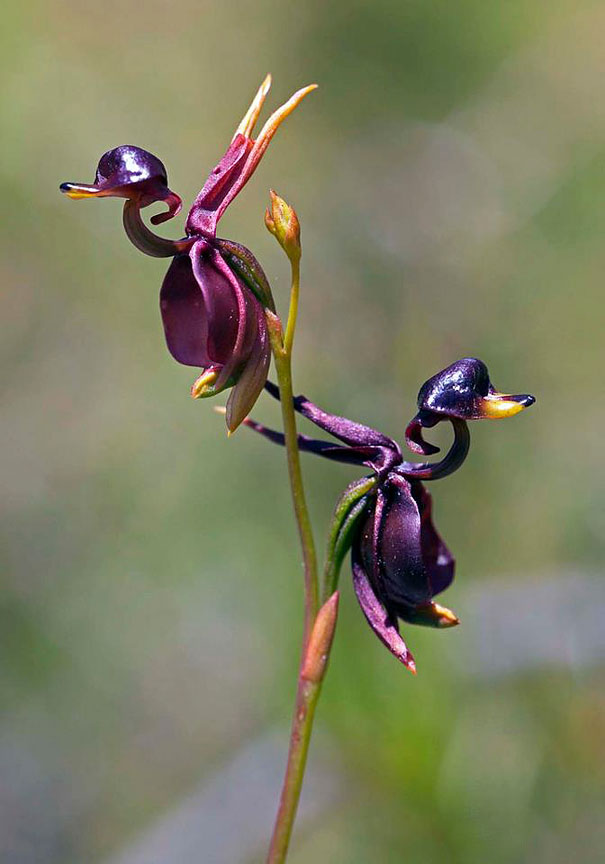 |
| Fly orchid. |
People who fixate on deep space and other planets for inspirational organisms really haven't been paying enough attention closer to home. We already have the most bizarre life forms imaginable, right under our noses...
Plants.
"Plants? Plants are boring!" you say.
Or not. Here are 10 amazing things about plants that will break your disbelieving little brain. You can't make this stuff up:
- Plants can swim! Some single-celled green algae (and other plants, like euglenids and dinoflagellates) have flagella they use to swim from place to place for their entire life, not just as gametes. How do they know where they want to go? Well...
- Plants can see! Yep, that's what I said. Some plants have an eye spot that can perceive light and tell the flagellum to whip them to a better location. So much for the Creationist's "half an eye is no use" hypothesis.
- Plants hunt! Many dinoflagellate species are photosynthetic, but most of those are actually mixotrophic--that is, they both make their own food, and eat prey. Noctiluca even eats fish eggs! And speaking of amazing dinoflagellates, these tiny plants are responsible for stunning bioluminescent tides.
- Plants are made of glass! Diatoms are tiny golden-brown algae that consist of about 98% silicon: almost pure glass. These plants have a bit of squishy genetic material sandwiched
 |
| Naked Man orchid |
between two nesting valves that look like glass petri dishes. Typically, they reproduce asexually, with the squishy stuff dividing, and each half taking one of the valves and regrowing the other. The problem is that they always regrow the nested valve, so some of the diatoms get smaller every generation until they finally have to have sex to reset the size. Billions of dead diatoms ultimately fall to the sea floor--forming layers up to hundreds of meters deep--and eventually become compressed into fine-grained stone called chert.
- Plants have alternating generations! Okay, this one is hard to conceptualize. Imagine that you are human, but when you have a child, it will be a cheetah. And your parents were
 |
| Flying Egret orchid |
earthworms. Your grandkids will be earthworms again. That's kind of how alternating generations work in some plants (well, ignoring that humans, cheetahs and earthworms don't have the same DNA). In many cases, they are so different that we thought for a long time that these stages were actually different species. The king of complex life histories is the wheat leaf rust, which goes through 5 different spores, living in 2 host plant species along the way.
- Flowers and fruit invented beauty! Before flowers came along, plants reproduced many inefficient ways; sometimes with spores, like ferns and fungi do; or by broadcasting incredible volumes of pollen to the wind, like pine trees do. Either way, you're just kind of throwing a Hail Mary and hoping it hits something useful. Works, but it's pretty random; and you certainly don't need to advertise, explaining why mushrooms are so cryptic (and often toxic). Flowers and fruits figured out that if they looked
 |
| Hooker's lips |
pretty enough (and tasted nice), they could lure unsuspecting animals into disseminating their genetic material for them. Clever. Which leads us to...
- Plants train humans! Thank Michael Pollan for this one. He wrote an entire (excellent) book about it.
- Some single-celled plants can work together to form larger creatures with specialized organs! Slime molds consist of perfectly functional single-celled protists that sometimes come together to get things done as a big, sticky puddle. For instance, and without any top-down management, some of these cells will choose to gang up to hunt (see #3), or to form fruiting bodies to produce spores.
- Some single-celled plants can work together to process information...without a brain! Remember I just mentioned that slime molds can organize without anyone telling them what to do? Well, they can also problem-solve without a brain.
- And last, but hardly least, Plants create chemical energy from sunlight, and build their bodies from air! If you didn't know this from almost your first memory, you would be
 |
| Flying Duck orchid |
flabbergasted. That the solid body of a Giant Sequoia is built from little more than the same gaseous carbon dioxide you exhale with every breath is astounding. And that photosynthesis changes sunlight into sugar is mysterious alchemy of the highest order. It's so familiar that it's hard to understand just how bizarre and rare it actually is. In point of fact, only 5% or less of all species on Earth are autotrophs. Everybody else eats. And of those measly 5%, all of them use chlorophyll to accomplish their magic. Chlorophyll is found in the chloroplast, an organelle that probably originated as an independent unicellular blue-green algae that was co-opted by other cells for their own use. Other organelles are thought to have originated like this, too: the mitochondria, for instance, which is like a little power generator (we know this because these organelles have their own unique DNA, and cannot be made by their host cell, but must be inherited during cell division). So, life on earth is dependent upon the strange occurrence of an organism that figured out how to eat sunshine, and the fact that other organisms thought it was such a good idea that they adopted that other living organism into their own cell structure. This is weird. In evolution, a good idea usually pops up many times: even eyes evolved independently 50-100 times (depending on how you define "eye").
So, if your life is lacking in awe, spend a few moments meditating on this...then go have a salad!






No comments:
Post a Comment